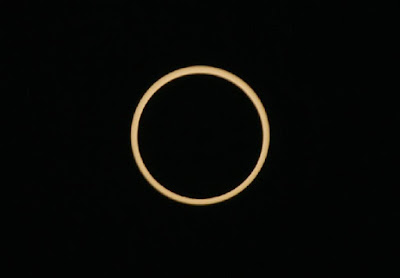A halo is an optical phenomenon produced by light interacting with ice crystals suspended in the atmosphere, resulting in a wide variety of colored or white rings, arcs and spots in the sky. Many halos are near the Sun or Moon, but others occur elsewhere or even in the opposite part of the sky. Among the most well known halo types are the circular halo (properly called the 22° halo), light pillars and sun dogs, but there are many more; some of them fairly common, others (extremely) rare.
The ice crystals responsible for halos are typically suspended in cirrus or cirrostratus clouds high (5–10 km, or 3–6 miles) in the upper troposphere, but in cold weather they can also float near the ground, in which case they are referred to as diamond dust. The particular shape and orientation of the crystals is responsible for the type of halo observed. Light is reflected and refracted by the ice crystals and may split up into colors because of dispersion. The crystals behave like prisms and mirrors, refracting and reflecting light between their faces, sending shafts of light in particular directions.
Atmospheric phenomena such as halos were used as part of weather lore as an empirical means of weather forecasting before meteorology was developed. They often do mean that rain is going to fall within the next 24 hours as the cirrostratus clouds that cause them can signify an approaching frontal system. Other common optical phenomena involving water droplets rather than ice crystals include the glory and the rainbow.
Light pillar
A light pillar, or sun pillar, appears as a vertical pillar or column of light rising from the sun near sunset or sunrise, though it can appear below the sun, particularly if the observer is at a high elevation or altitude. Hexagonal plate- and column-shaped ice crystals cause the phenomenon. Plate crystals generally cause pillars only when the sun is within 6 degrees of the horizon, or below it; column crystals can cause a pillar when the sun is as high as 20 degrees above the horizon. The crystals tend to orient themselves near-horizontally as they fall or float through the air, and the width and visibility of a sun pillar depends on crystal alignment.
Light pillars can also form around the moon, and around street lights or other bright lights. Pillars forming from ground-based light sources may appear much taller than those associated with the sun or moon. Since the observer is closer to the light source, crystal orientation matters less in the formation of these pillars.
Circular halo
Among the most well known halos is the 22° halo, often just called "halo", which appears as a large ring around the Sun or Moon with a radius of about 22° (roughly the width of an outstretched hand at arm's length). The ice crystals that cause the 22° halo are oriented semi-randomly in the atmosphere, in contrast to the horizontal orientation required for some other halos such as sun dogs and light pillars. As a result of the optical properties of the ice crystals involved, no light is reflected towards the inside of the ring, leaving the sky noticeably darker than the sky around it, and giving it the impression of a "hole in the sky". The 22° halo is not to be confused with the corona, which is a different optical phenomenon caused by water droplets rather than ice crystals, and which has the appearance of a multicolored disk rather than a ring.




















0 Comments